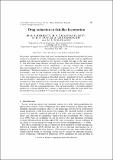| dc.contributor.author | Barrett, D.S. | |
| dc.contributor.author | Triantafyllou, M.S. | |
| dc.contributor.author | Yue, D.K.P. | |
| dc.contributor.author | Grosenbaugh, M.A. | |
| dc.contributor.author | Wolfgang, M.J. | |
| dc.date.accessioned | 2005-08-23T05:59:54Z | |
| dc.date.available | 2005-08-23T05:59:54Z | |
| dc.date.issued | 1999 | |
| dc.identifier.uri | http://hdl.handle.net/1721.1/25618 | |
| dc.description.abstract | We present experimental force and power measurements demonstrating that the power
required to propel an actively swimming, streamlined, fish-like body is significantly
smaller than the power needed to tow the body straight and rigid at the same speed
U. The data have been obtained through accurate force and motion measurements
on a laboratory fish-like robotic mechanism, 1:2m long, covered with a flexible
skin and equipped with a tail fin, at Reynolds numbers up to 10^6, with turbulence
stimulation. The lateral motion of the body is in the form of a travelling wave with
wavelength lambda and varying amplitude along the length, smoothly increasing from the
front to the tail end. A parametric investigation shows sensitivity of drag reduction
to the non-dimensional frequency (Strouhal number), amplitude of body oscillation
and wavelength lambda, and angle of attack and phase angle of the tail fin. A necessary
condition for drag reduction is that the phase speed of the body wave be greater than
the forward speed U. Power estimates using an inviscid numerical scheme compare
favourably with the experimental data. The method employs a boundary-integral
method for arbitrary flexible body geometry and motions, while the wake shed from
the fish-like form is modelled by an evolving desingularized dipole sheet. | en |
| dc.format.extent | 2407645 bytes | |
| dc.format.mimetype | application/pdf | |
| dc.language.iso | en_US | en |
| dc.publisher | Cambridge University Press | en |
| dc.rights | Copyright: Cambridge University Press
This material is presented to ensure timely dissemination of scholarly and technical work. Copyright and all rights therein are retained by authors or by other copyright holders. All persons copying this information are expected to adhere to the terms and constraints invoked by each author's copyright. In most cases, these works may not be reposted without the explicit permission of the copyright holder. | |
| dc.subject | drag reduction | en |
| dc.subject | fish-like locomotion | en |
| dc.title | Drag reduction in fish-like locomotion | en |
| dc.type | Article | en |
| dc.identifier.citation | Journal of Fluid Mechanics, 392, p.183-212 (1999) | en |
| dc.contributor.department | Massachusetts Institute of Technology. Department of Mechanical Engineering | |
